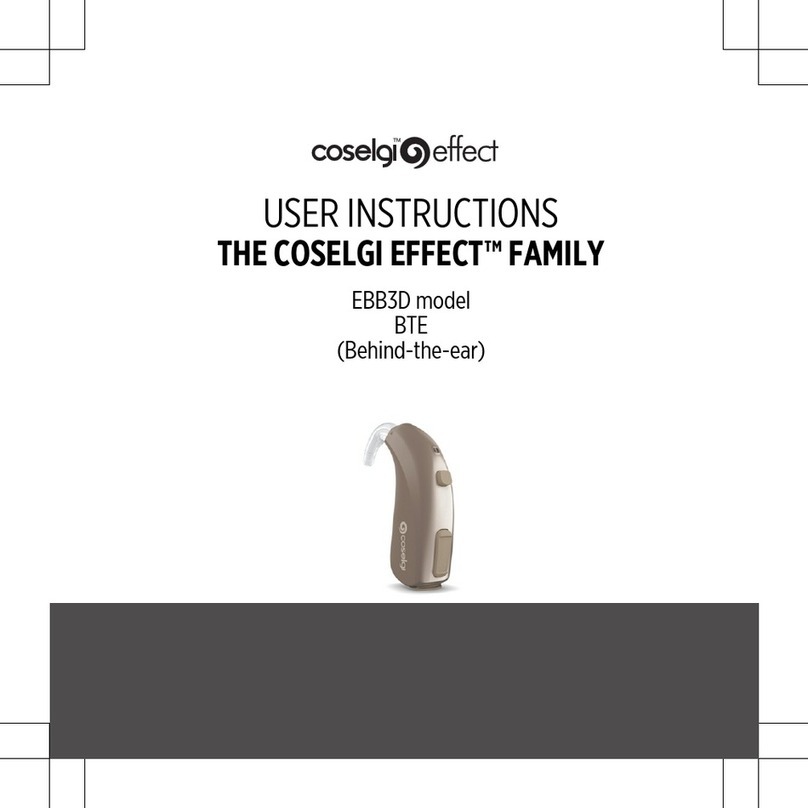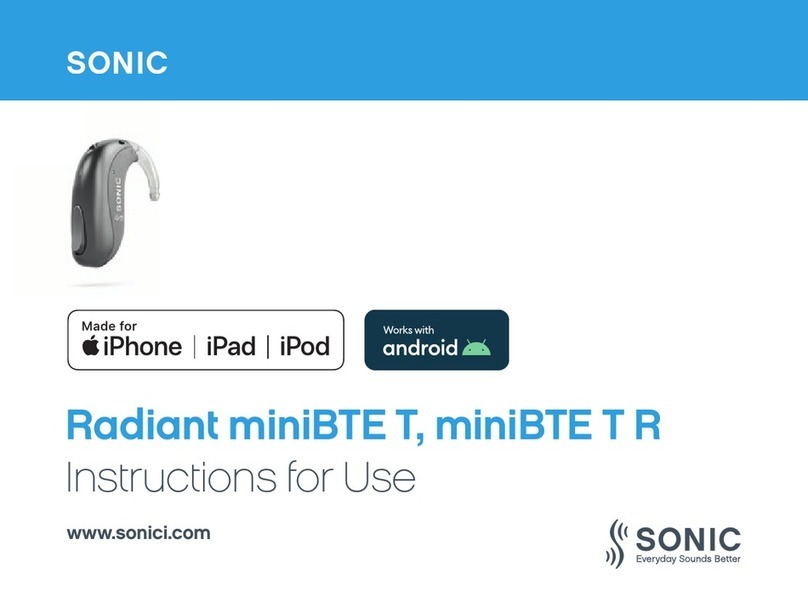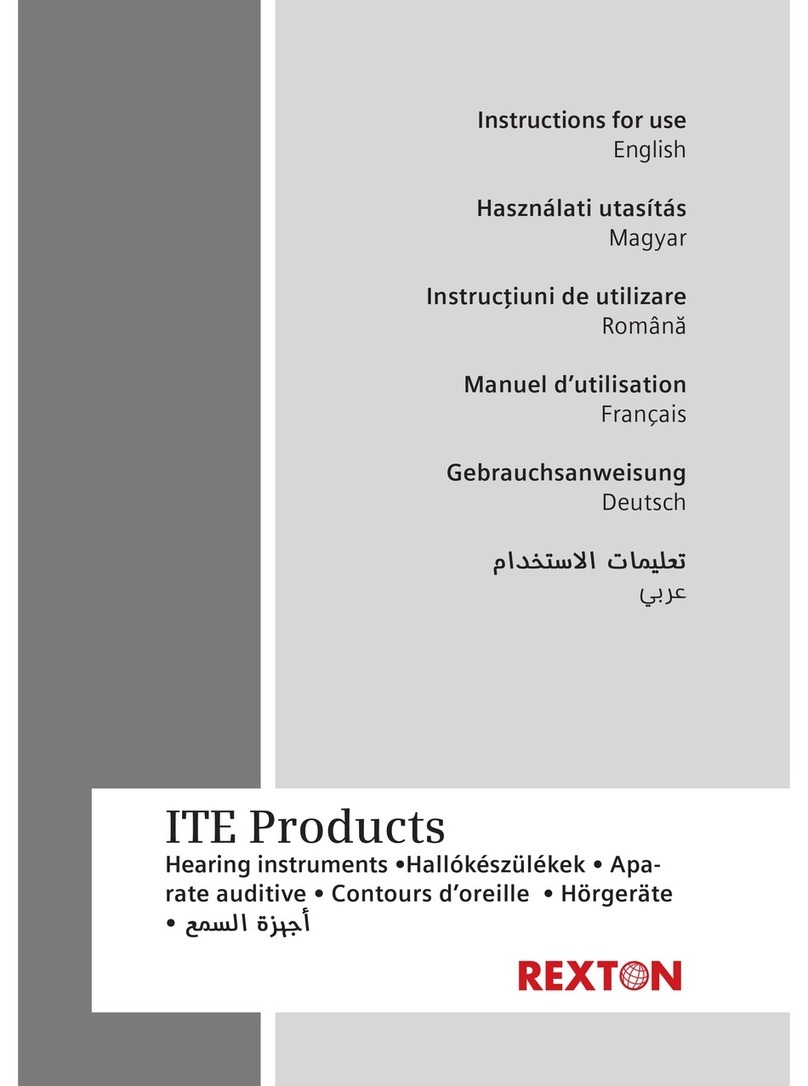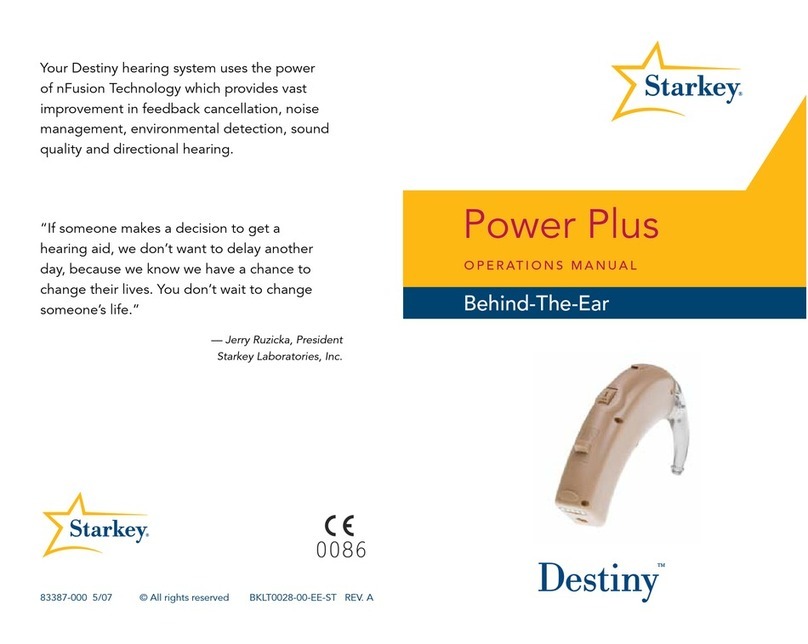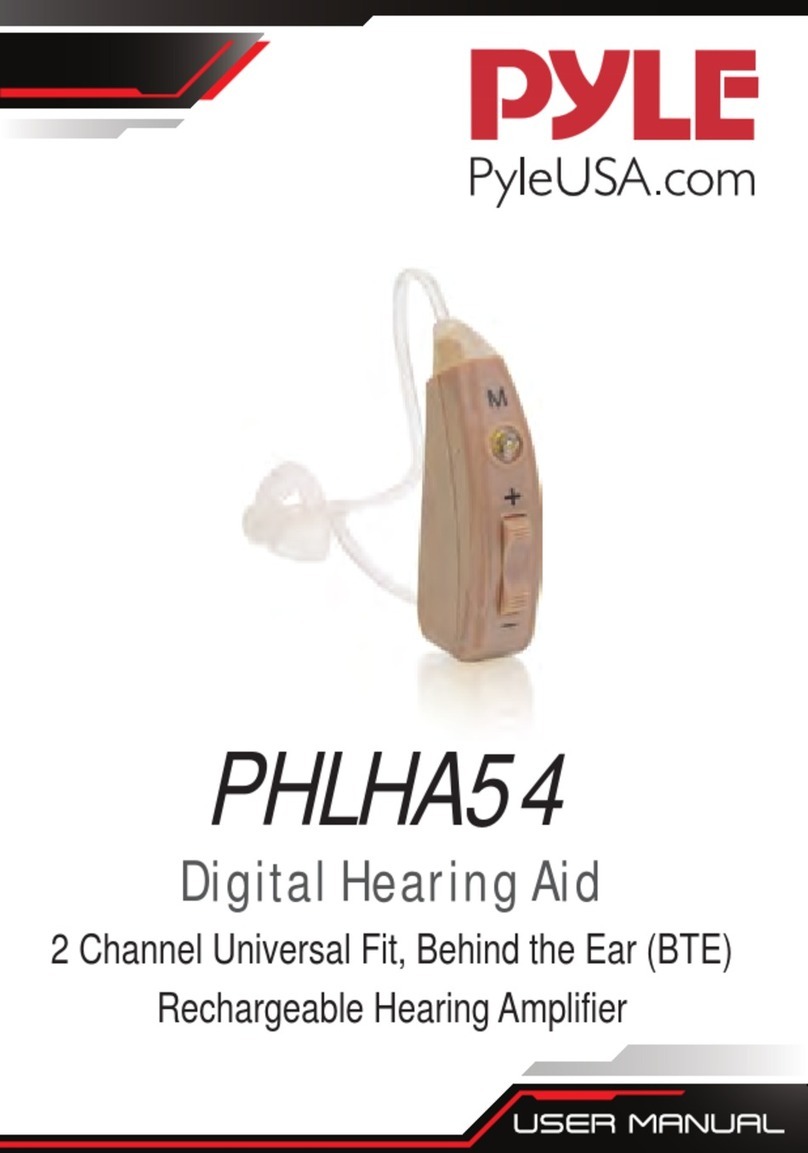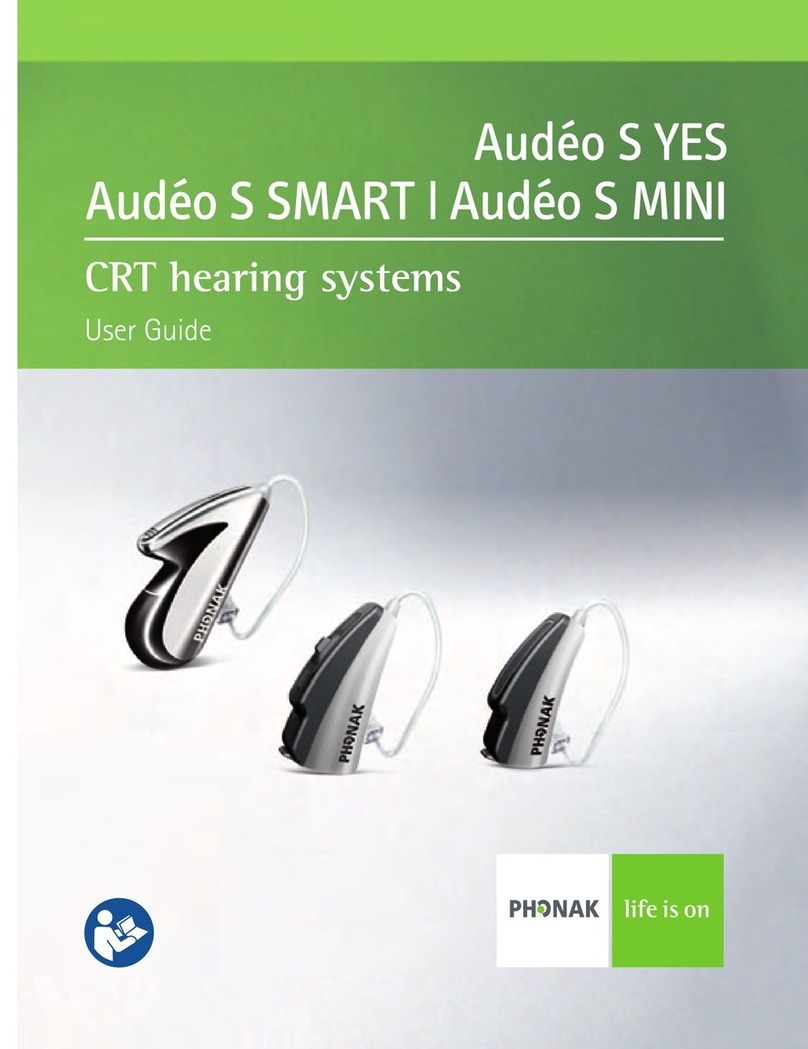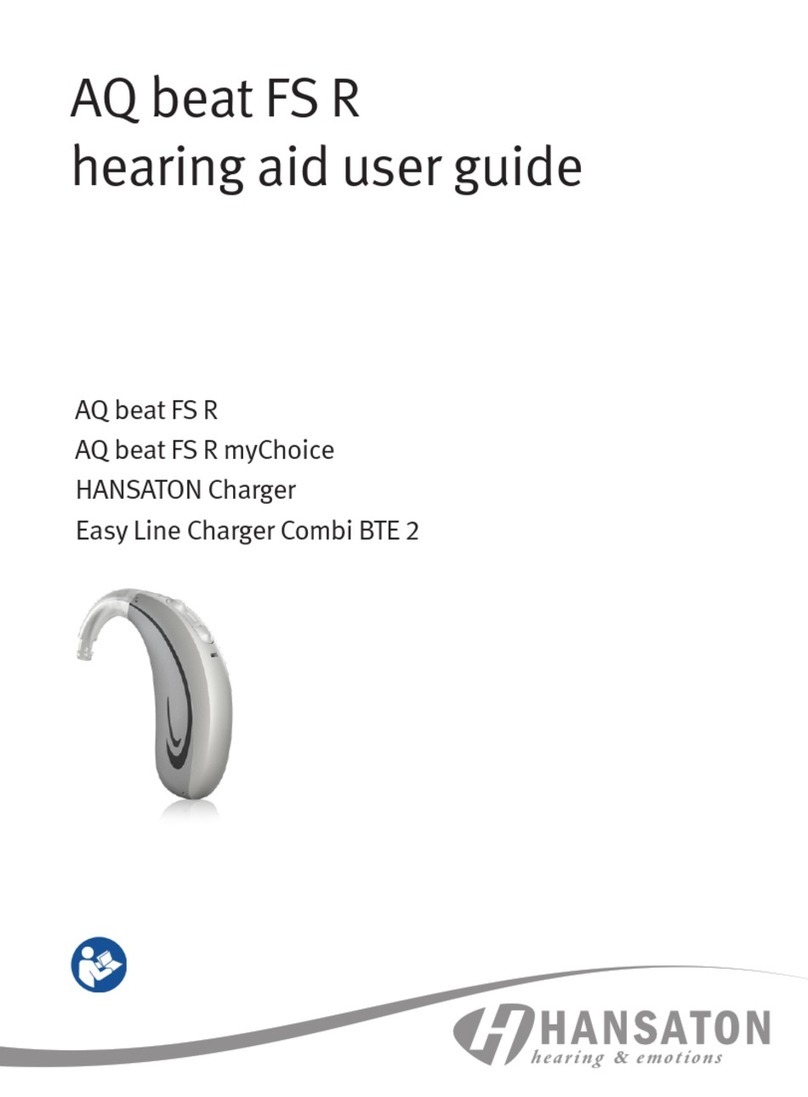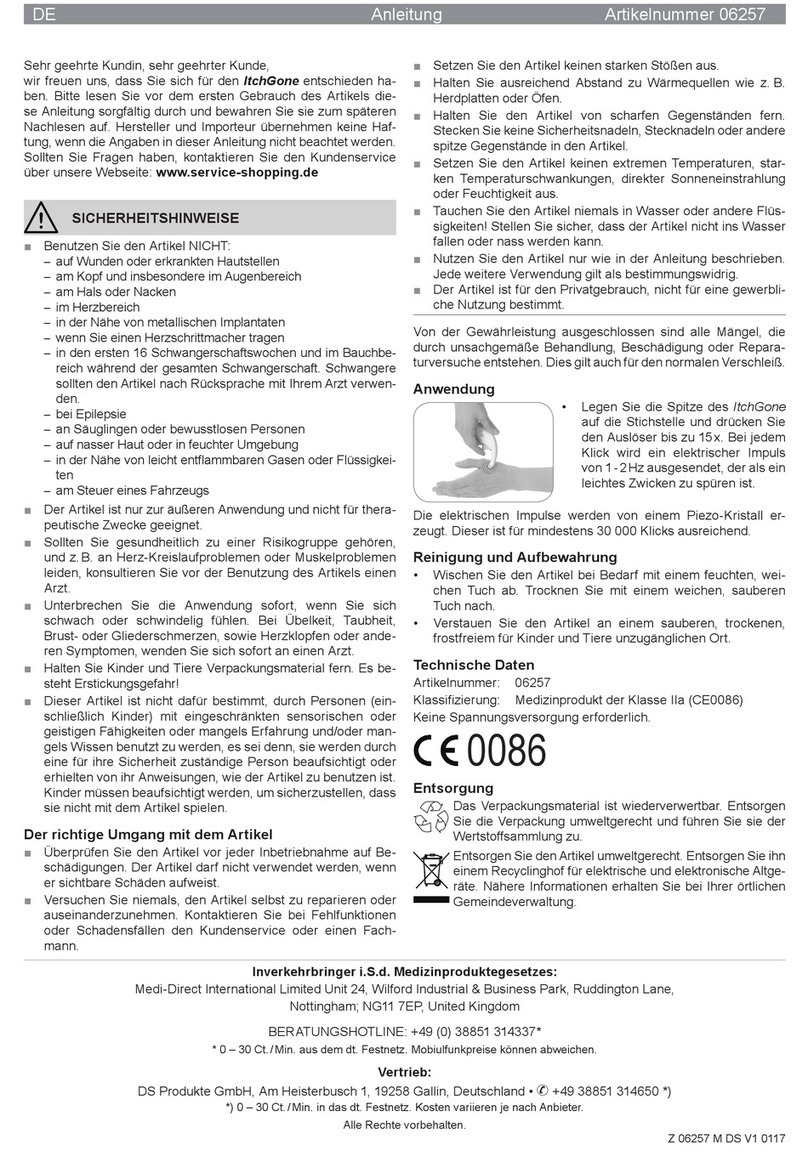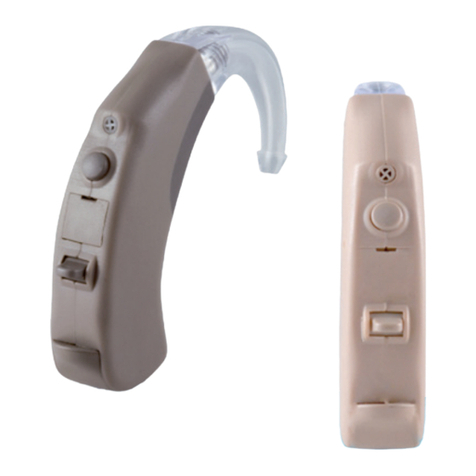Electone 06E123456L User manual

Operating Instructions
for Hearing Instruments

i
i
Your hearing care provider has
carefully prescribed an Electone
hearing instrument designed to meet
your individual hearing requirements.
This booklet contains operating
instructions for your specific hearing
instrument as well as operating
instructions for other hearing
instrument models. Refer to the Table
of Contents for instructions on using
your particular instrument.
Electone hearing instruments are
manufactured and tested to stringent
quality control standards, ensuring
excellent performance. Your decision
to purchase Electone hearing
instruments reflects the importance
you place on quality and reliability.

ii
ii
Welcome to Better Hearing!
Congratulations! You are about to enter a new
world of better hearing.
As you become familiar with your hearing
instruments, you will be able to live a fuller life
enjoying the sounds of your environment, your
family and your friends.
Please keep in mind that learning to use
your hearing instruments requires a period
of adjustment and patience. The adjustment
period varies for each individual depending on
your dedication and motivation.
Remember that just as hearing loss generally
occurs gradually over time, it may take time to
get used to the sounds hearing instruments
bring back. Take time to familiarize your family
with your new instruments and ask them to work
with you and to be patient as you rediscover
sounds you haven’t heard for awhile.

iii
iii
Table of Contents
Getting The Most From Your Hearing Instruments .........1
Binaural Amplification ......................................................... 2
Custom In-the-Ear Hearing Instruments .........................3
Getting Familiar With Your Custom In-the-Ear Instruments ..3
Inserting the Battery ........................................................... 4
Inserting and Removing the Instruments ........................... 5
Inserting and Removing the CIC Hearing Instrument ....... 5
Volume Controls .................................................................. 6
Manual Volume Controls .................................................... 7
Screw Set Volume Controls ................................................ 8
Directional Microphone System ......................................... 8
Using the Telephone ........................................................... 9
Telecoil Switches ................................................................. 9
Behind-The-Ear Hearing Instruments ............................10
Getting Familiar With Your Behind-the-Ear Instruments . 10
Inserting the Battery ......................................................... 11
How To Put On the Instruments ....................................... 12
BTE Volume Controls ........................................................ 13
Using the Telephone ......................................................... 14
Microphone-Telecoil Controls .......................................... 14
Audio Input ........................................................................ 16

iv
iv
Battery Compartment Safety Lock for BTE Hearing
Instruments ........................................................................ 17
Open Fit Behind-the-Ear (BTE) Hearing Instruments ..17
Digitally Programmable Hearing Instruments ..............18
Using the Optional Memory Selection Switch ................. 19
Reset Function .................................................................. 21
General Use ....................................................................... 21
Digital Hearing Instruments ........................................... 22
General Use ....................................................................... 22
Maintenance & Daily Care .............................................. 23
Health Considerations ................................................... 27
Important Notice to Hearing Instrument Users ............. 27
Hearing Instrument Warranty ........................................ 29
Replacement Opportunity ................................................ 31
To Return Your Hearing Instruments for Service .............. 31
Warranty Information ........................................................ 32
Battery Tips ..................................................................... 33
Battery Sizes for Hearing Instruments .......................... 35
Troubleshooting Hearing Instruments .......................... 36

1
1
Getting The Most From Your Hearing
Instruments
From the first fitting of your hearing instruments
there are things that you can do to increase
your listening satisfaction. Remember that there
may be sounds, both wanted and unwanted,
you may not have heard for a long time.
Practice identifying and then ignoring sounds
which at first may be disturbing to you.
Below are suggested guidelines for adjusting
to your new hearing instruments. Your hearing
care professional may provide additional or
modified guidelines to meet your individual
needs.
• For the first few days wear your hearing
aids in surroundings in which you are most
comfortable. For instance, you might only
wear them for a few hours a day at home.
• Increase your wearing time gradually as the
hearing aids become more familiar to you.
• If at any time you feel nervous or tired,
turn your hearing aids off and rest awhile.
Remember, your ultimate goal is daily all - day
use.

2
2
• Converse with only one person at a time
initially until you feel comfortable using your
instruments. Then move on to group listening
situations.
• When engaging in group conversations,
request that one person speak at a time.
• When in a church or theater, experiment with
finding a place to sit where you can hear best.
Don’t be discouraged. It may simply be a
matter of finding the proper spot in order to
hear more clearly.
Binaural Amplification
Nature gives us two ears for a reason. Binaural
amplification (the wearing of two hearing
instruments) is recommended to receive the
full benefits of amplification. By wearing two
hearing instruments, both ears receive sound
signals allowing for improved clarity, a sense
of direction, more balanced sound, and more
relaxed listening.
Binaural amplification may provide improved
understanding along with better hearing.

3
3
Custom In-the-Ear Hearing
Instruments
Getting Familiar With Your Custom In-the-
Ear Instruments
Your in-the-ear hearing instruments are custom-
fit to the contours of your ear. Red or blue
laser-etched numbers on the instruments’
shells denote the manufacturer, size, year
of manufacture, and the serial number. Red
numbers indicate the instrument is for the right
ear, blue is for the left.
In-the-Ear In-the-Canal
Electone FS
06E123456[L or R]
Microphone
Battery Door
Volume Control
On-Off Switch
Vent
Laser-etched
Serial Number
(on back side)
Laser-etched
Serial Number
(on back side)
Manufacturer Size of instrument
Year of manufacture Serial number Left or Right instrument

4
4
Inserting the Battery
To insert the battery, pull the tab on the battery
door outward until the door swings all the way
open (see figure 1). Remove the paper tab
from the back of a proper size battery. Place
the battery into the battery door (see figure 2).
Observe the correct polarity. The “+” sign on
the battery must match the “+” sign stamped
on the battery door.
Gently close the battery door. Avoid forcing
the battery door shut. If the door doesn’t
close, check to see the correct size battery was
inserted and that the “+” signs are aligned.
If your instrument’s battery door does not have
a “+” sign, insert the proper size battery and
gently close the battery door. If it doesn’t close
easily, remove the battery, turn it over and
reinsert it. The battery door should now close
easily.
Battery
door
Figure 1
“+” Positive Sign
Figure 2

5
5
Inserting and Removing the Instruments
Hold the instrument between your thumb and
index finger (see figure 3). Turn down the volume
(if applicable) to reduce feedback (a whistling
sound). (See note on page 6.) With the face of
the instrument facing away from the ear, place
the canal portion into your ear canal. Gently work
the instrument into its proper position by slightly
twisting until it is firmly seated in your ear. Lightly
press inward for a secure and comfortable fit (see
figure 4).
When removing the instrument, reverse the
insertion process. It often helps to push on
the back of the ear to help release the hearing
instrument.
Inserting and Removing the CIC Hearing
Instrument
With the removal cord on the bottom, guide the
CIC into your ear canal (see figure A). Once it’s
in the ear canal, lightly pull on your earlobe and
Figure 3 Figure 4 Figure A Figure B
Removal
Cord
Removal
Cord

6
6
press the CIC in place. If you experience irritation,
inflammation, or pain when inserting your CIC
hearing instrument, immediately contact your
hearing care provider.
To remove the CIC, simply grasp the removal cord
with your thumb and index finger and gently pull
the CIC out of your ear canal (see figure B).
CAUTION! Do not pull on the volume control or
battery door as this may cause damage to the
hearing instrument.
NOTE: Your hearing instrument may include a
feature which delays “power-on” of the instrument
for a few seconds to allow insertion without
feedback. Your hearing instrument provider will
inform you if this feature is present.
Volume Controls
Your hearing instruments may be equipped with
one of many different types of volume controls.
Most volume control options available today
also control the on/off function of the hearing
instrument.
If your instruments do not have this feature,
the battery door must be opened or the battery
removed to turn off the instruments and prevent
battery drain. If you are not certain about which

7
7
type of volume controls your custom hearing
instruments use, be sure to ask your hearing
care provider.
Manual Volume Controls
The wheel shaped controls are rotated to select
the most desirable listening position (louder
or softer). Be sure volume controls are set at
minimum before placing instruments in your
ears.
To turn the instrument on and
increase volume, place the
forefinger gently against the
wheel and turn, rotating the
wheel in a forward direction
(towards your nose). When the
wheel stops, the instrument is at
full volume (see figure 6).
To reduce volume, rotate the wheel backward
(toward the back of your head or away from
your nose). When the wheel will not turn any
further, the instrument is off.
Do not force the volume control past the stops
in either direction.

8
8
Screw Set Volume Controls
Your hearing care provider will adjust screw set
volume controls. There is no on/off switch built
into the screw set volume control. To turn off
your instruments, you must leave the battery
door open or remove the battery. An optional
on/off toggle switch may be used if space is
available.
Directional Microphone System
Your hearing instrument may be equipped
with a Directional Microphone System. For
listening in noisy situations (directional mode),
simply move the microphone switch forward.
For listening in a quiet environment (omni-
directional mode), move the switch backward
(see figure 7).
Figure 7

9
9
Using the Telephone
You may use the telephone in a normal manner.
If you experience a whistling sound (feedback),
tilt the phone receiver away from your ear and/
or reduce the volume until the whistling stops.
By trying various positions of the telephone
receiver, you will discover what works best for
you.
Telecoil Switches
Some custom hearing instrument models may
be equipped with a toggle telephone switch
that changes your hearing instruments from
microphone position to telecoil position. In
the telecoil position, your hearing instruments
are compatible with the telephone so you
will be able to hear without a whistling sound
(feedback).
Your hearing care professional may have
chosen a “switchless” telecoil rather than
a telecoil switch. This type of telecoil
automatically switches between microphone
and telecoil position when your hearing
instrument compatible telephone is moved
close to the instrument.

10
10
For Digitally Programmable Instrument
Users
If your custom in-the-ear hearing instruments
are digitally programmable, refer to page 18 for
additional information.
Behind-The-Ear Hearing Instruments
Getting Familiar With Your Behind-the-Ear
Instruments
Your behind-the-ear instrument is designed
for comfort, performance and durability. The
instrument fits comfortably behind your ear and
is attached to a custom-made earmold.
Your hearing care provider will advise the
location of the serial
number for your
particular model.
Earhook
Tubing
Earmold
Battery
door
Memory
(if applicable)
Volume
Control
(rocker volume
control shown)

11
11
Inserting the Battery
To insert the battery, pull the tab on the battery
door outward until the door swings all the way
open. Remove the paper tab from the back of
a proper size battery. Place the battery into the
battery door. Observe the correct polarity. The
“+” sign on the battery must match the “+” sign
stamped on the battery door (see figure 8).
Gently close the battery door. Avoid forcing
the battery door shut. If the door doesn’t
close, check to see the correct size battery was
inserted and that “+” signs are aligned.
If your instrument’s battery door does not have
a “+” sign, insert the proper size battery and
gently close the battery
door. If it doesn’t close
easily, remove the battery,
turn it over and reinsert it.
The battery door should
now close easily.
Figure 8

12
12
How To Put On the Instruments
Hold the earmold between your thumb and
index finger (see figure 9). Turn down the
volume (if applicable) to reduce feedback.
Place the earmold into your ear canal. Gently
work the earmold into its proper position by
slightly twisting until it is firmly seated in your
ear. Lightly press inward for a secure and
comfortable fit (see figure 10). Slip the hearing
instrument behind your ear.
When removing the instrument, reverse the
insertion process. It often helps to push on the
back of the ear to help release the earmold.
Figure 9 Figure 10

13
13
BTE Volume Controls
Behind-the-ear hearing instruments are
equipped with either a wheel or rocker volume
control.
A wheel volume control has four
levels of volume, with 1 (I) being
the lowest sound level and 4 (IV)
being the highest sound level (see
figure 11). (Some wheel volume
controls are not numbered.)
A rocker volume control
incrementally adjusts the volume.
To decrease volume, press the
bottom (wide) portion of the
control. To increase volume, press
the top (narrow) portion of the
control (see figure 11A). Some
instruments with a rocker control
may “beep” when the instrument
reaches minimum and maximum volume.
For both types of volume controls, adjust the
volume to a comfortable listening level for
each ear. Initially, you may wish to do this in a
quiet room while another individual speaks at a
normal conversational level.
Figure 11
Figure 11A

14
14
Using the Telephone
To use the telephone, place the receiver of the
telephone above your ear and on the hearing
instrument, then try tilting the phone receiver.
You will discover what works best for you.
Microphone-TelecoilControls
Your behind the ear instruments may be
equipped with either a Microphone-Telecoil
push button or a Microphone-Telecoil-Off
switch.
The Microphone-Telephone push button
toggles between microphone and telecoil
programs (see figure 12). The microphone
program is for use during normal listening
situations. Pressing the button
changes the program to telecoil.
Figure 12

15
15
The Microphone-Telecoil-Off
switch features three program
positions (see figure 12A). During
normal use the M-T-O switch
is worn in the microphone (M)
position. Moving the switch to the
telecoil (T) position changes the
program to telecoil.
In the telecoil position for both the Microphone-
Telecoil push button and Microphone-Telecoil-
Off switch, your instruments are compatible
with the electro-magnetic field of the telephone
and you will be able to hear without a whistling
sound (feedback).
Figure 12A
This manual suits for next models
1
Table of contents
